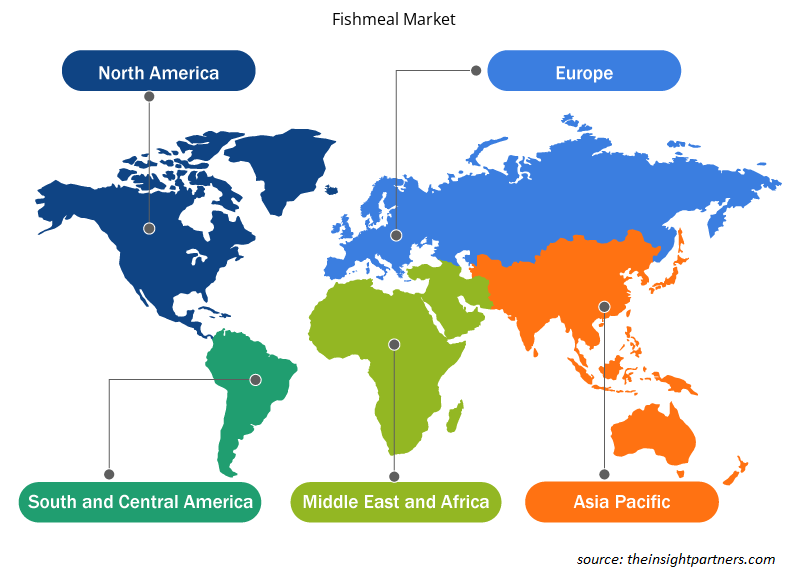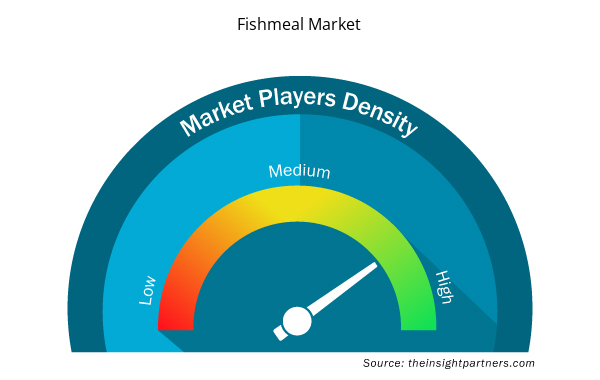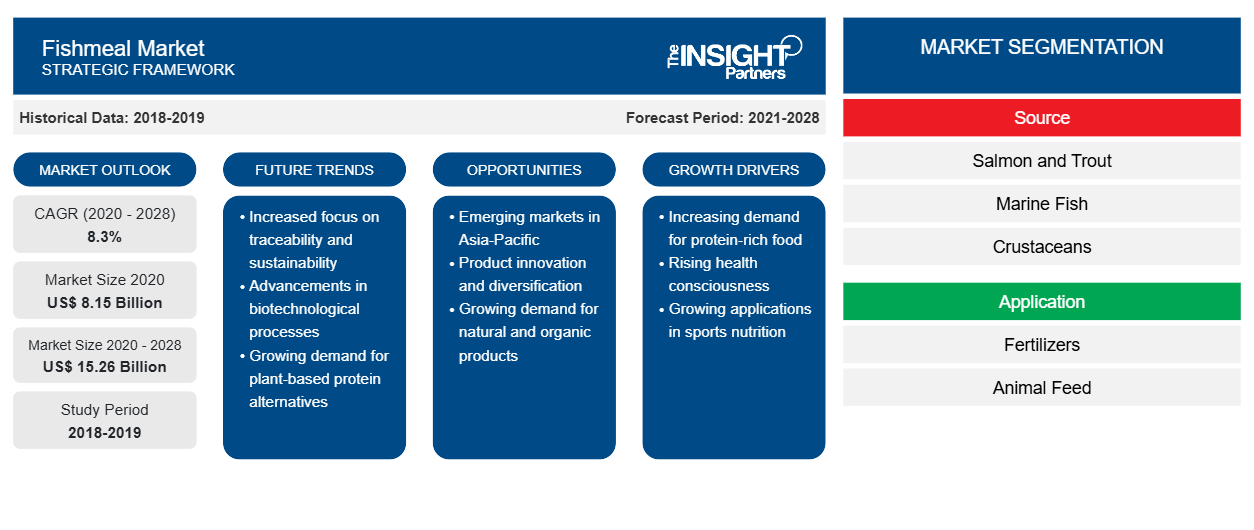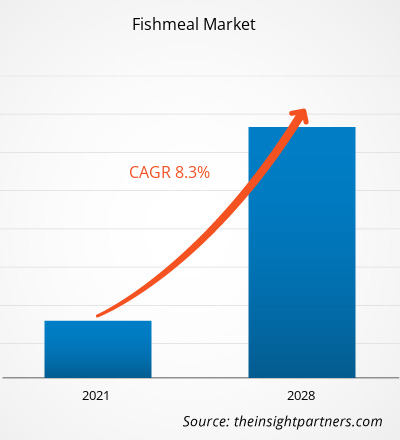El mercado de harina de pescado se valoró en US$ 8.153,6 millones en 2020 y se proyecta que alcance los US$ 15.264,6 millones en 2028; se espera que crezca a una CAGR del 8,3% entre 2021 y 2028.
La harina de pescado se produce a partir de subproductos de pescado de las industrias de procesamiento y fileteado de alimentos. Se utiliza principalmente como ingrediente de alto contenido proteico (60-72%) en piensos producidos para animales de granja y especies de acuicultura. La demanda de harina de pescado supera la oferta; por lo tanto, la industria de piensos ha cambiado considerablemente la composición de la harina de pescado en los piensos. El mercado de la harina de pescado ha sido testigo del crecimiento a lo largo del período histórico debido al desarrollo de la acuicultura debido a la creciente demanda de productos del mar y la creciente dependencia de la acuicultura por parte de los países en desarrollo para resolver la escasez de alimentos. Además, la harina de pescado es sostenible por naturaleza, ya que se produce a partir de componentes de desecho de otras industrias. Por lo tanto, forma parte de varios programas de conservación ambiental. De este modo, el mercado se beneficia de prácticas sostenibles, como la agricultura orgánica.
En 2020, Asia-Pacífico tuvo la mayor participación en los ingresos del mercado mundial de harina de pescado . Además, se espera que la región registre la CAGR más alta durante el período de pronóstico. Asia-Pacífico comprende varias economías importantes como India, China, Japón, Corea del Sur y Australia. Estos países están presenciando un aumento en la industrialización en el sector alimentario y las actividades de urbanización, ofreciendo amplias oportunidades para los actores clave en el mercado de harina de pescado. Se anticipa que Asia-Pacífico será testigo de una creciente demanda de harina de pescado en los próximos años debido a la presencia de numerosos actores nacionales de nivel pequeño y mediano en el mercado. Durante el período de pronóstico, se espera que el mercado de harina de pescado sea testigo de una gran demanda de las industrias de acuicultura y agricultura orgánica debido a su perfil altamente nutritivo que contiene aminoácidos esenciales. Además, la harina de pescado encuentra aplicaciones en las industrias nutracéutica, farmacéutica y otras. Se espera que el mercado de harina de pescado en Asia-Pacífico crezca durante el período de pronóstico debido al enorme crecimiento en el sector de la acuicultura, especialmente en India y China. Además, el aumento de la población y el creciente apoyo gubernamental están impulsando el crecimiento del mercado en la región.
Personalice este informe según sus necesidades
Obtendrá personalización en cualquier informe, sin cargo, incluidas partes de este informe o análisis a nivel de país, paquete de datos de Excel, así como también grandes ofertas y descuentos para empresas emergentes y universidades.
- Obtenga las principales tendencias clave del mercado de este informe.This FREE sample will include data analysis, ranging from market trends to estimates and forecasts.
The COVID-19 pandemic has negatively impacted the fisheries industry with disruptions in its supply chain. The decline in the demand for seafood has resulted in the decreased production of fish. Low fish demand reduced fish fleet activities, which negatively impacted the production of fish by-products, especially fishmeal. However, with the launch of vaccination drives globally, the economies are reviving, and industries are witnessing demand for their products. Various governments are also taking initiatives to minimize the loss of the fisheries industry due to this pandemic. With this, the fishmeal market is expected to witness growth in the coming years.
Market Insights
Increasing Demand for Protein Rich Animal Feed
The industrialization of animal farming has increased the demand for protein-rich animal feed ingredients to raise the feed conversion rate. Industrially raised livestock are mainly fed on concentrates made from cereal and vegetable protein such as soybean meals to assist them in gaining weight and producing protein-rich meat. Farm animals depend on proteins and other elements as building blocks essential for growth. Proteins in animal feeds are an excellent energy source and essential amino acids, such as lysine and methionine. The growing awareness about the health benefits of proteins on animal health has created a substantial demand for various protein feeds, such as animal protein meals, feather meals, fishmeal, bone meal, and blood meal. Fishmeal is a rich source of protein, minerals, and fatty acids and is easily digested by the livestock upon consumption. High-quality fishmeal enables the formulation of nutrient-dense livestock diets, promoting their optimal growth. As livestock and farm animals contribute significantly to the global food supply chain, the demand for protein-rich nutritious animal feed is rising and is expected to continue during the forecast period. The constantly burgeoning demand for protein-rich animal feeds to promote growth in livestock at all stages of life is driving the overall fishmeal market substantially.
Source Insights
Based on source, the global fishmeal market is segmented into salmon, mackerel, anchovy, capelin, and others. In 2020, the anchovy segment accounted for the largest revenue share. Anchovies are majorly found in SAM, especially in Peru. The volume of fishmeal production manufactured from Peruvian anchovies is equivalent to the requirement of half of the global fed farmed fish production. The market for the anchovy segment is expected to witness growth during the forecast period due to the availability of anchovies in ample quantity. The high availability of anchovies also has a positive impact on the global food security.
Application Insights
Based on application, the global fishmeal market is segmented into animal feed, agriculture, and others. In 2020, the animal feed segment accounted for the largest revenue share. Fishmeal is a highly digestible feed ingredient, carrying a high amount of energy per unit weight. It contains little carbohydrate and is an excellent source of vitamins, minerals, oils (lipids), and proteins. Many commercial fishmeal are made from small and bony fishes, which are not suitable for consumption by human or manufactured from by-products of the fish processing industry. Therefore, the valorization of by-products makes the fishmeal animal feed economical. Hence, the enhancement of animal feed with the help of fishmeal is driving the market growth for this segment.
TripleNine, The Scoular Company, FF SKAGEN A/S, Pelagia AS, Soytex LTD, Pesquera Diamante S.A., TASA, Oceana Group Limited, Omega Protein Corporation, and COPEINCA are a few well-established players in the global fishmeal market. Companies in the market are adopting strategies such as product developments, plant expansions, and mergers and acquisitions to expand their footprint worldwide and meet the growing demand from end users. For instance, in September 2021, Scoular launched a new brand Encompass for its growing fishmeal business.
Fishmeal Market Regional Insights
The regional trends and factors influencing the Fishmeal Market throughout the forecast period have been thoroughly explained by the analysts at Insight Partners. This section also discusses Fishmeal Market segments and geography across North America, Europe, Asia Pacific, Middle East and Africa, and South and Central America.

- Get the Regional Specific Data for Fishmeal Market
Fishmeal Market Report Scope
| Report Attribute | Details |
|---|---|
| Market size in 2020 | US$ 8.15 Billion |
| Market Size by 2028 | US$ 15.26 Billion |
| Global CAGR (2020 - 2028) | 8.3% |
| Historical Data | 2018-2019 |
| Forecast period | 2021-2028 |
| Segments Covered | By Source
|
| Regions and Countries Covered | North America
|
| Market leaders and key company profiles |
|
Fishmeal Market Players Density: Understanding Its Impact on Business Dynamics
The Fishmeal Market market is growing rapidly, driven by increasing end-user demand due to factors such as evolving consumer preferences, technological advancements, and greater awareness of the product's benefits. As demand rises, businesses are expanding their offerings, innovating to meet consumer needs, and capitalizing on emerging trends, which further fuels market growth.
La densidad de actores del mercado se refiere a la distribución de las empresas o firmas que operan dentro de un mercado o industria en particular. Indica cuántos competidores (actores del mercado) están presentes en un espacio de mercado determinado en relación con su tamaño o valor total de mercado.
Las principales empresas que operan en el mercado de harina de pescado son:
- Triple nueve
- La Compañía Scoular
- FF SKAGEN A/S
- Pelagia AS
- Soytex Ltd.
Descargo de responsabilidad : Las empresas enumeradas anteriormente no están clasificadas en ningún orden particular.

- Obtenga una descripción general de los principales actores clave del mercado de harina de pescado
Informe Destacado
- Tendencias progresivas de la industria en el mercado mundial de harina de pescado para ayudar a los actores a desarrollar estrategias efectivas a largo plazo
- Estrategias de crecimiento empresarial adoptadas por los mercados desarrollados y en desarrollo
- Análisis cuantitativo del mercado mundial de harina de pescado de 2019 a 2028
- Estimación de la demanda de harina de pescado en diversas industrias
- Desarrollos recientes para comprender el escenario competitivo del mercado y la demanda de harina de pescado
- Tendencias y perspectivas del mercado junto con los factores que impulsan y restringen el crecimiento del mercado de harina de pescado
- Proceso de toma de decisiones mediante la comprensión de las estrategias que sustentan el interés comercial con respecto al crecimiento del mercado mundial de harina de pescado
- Tamaño del mercado de harina de pescado en varios nodos del mercado
- Descripción detallada y segmentación del mercado mundial de harina de pescado, así como su dinámica en la industria.
- Tamaño del mercado de harina de pescado en varias regiones con oportunidades de crecimiento prometedoras
Mercado de harina de pescado, por origen
- Salmón
- Caballa
- Anchoa
- Capelán
- Otros
Mercado de harina de pescado, por aplicación
Perfiles de empresas
- Triple nueve
- La Compañía Scoular
- FF SKAGEN A/S
- Pelagia AS
- Soytex Ltd.
- Pesquera Diamante SA
- TASA
- Grupo Oceana Limitada
- Corporación de Proteínas Omega
- COPEANCA
- Análisis histórico (2 años), año base, pronóstico (7 años) con CAGR
- Análisis PEST y FODA
- Tamaño del mercado Valor/volumen: global, regional, nacional
- Industria y panorama competitivo
- Conjunto de datos de Excel


- Nuclear Waste Management System Market
- Investor ESG Software Market
- Latent TB Detection Market
- Queue Management System Market
- Aircraft Wire and Cable Market
- Adaptive Traffic Control System Market
- Aerospace Forging Market
- Animal Genetics Market
- Advanced Planning and Scheduling Software Market
- Sweet Potato Market

Report Coverage
Revenue forecast, Company Analysis, Industry landscape, Growth factors, and Trends

Segment Covered
This text is related
to segments covered.

Regional Scope
North America, Europe, Asia Pacific, Middle East & Africa, South & Central America

Country Scope
This text is related
to country scope.
Preguntas frecuentes
Industrial livestock production has ensured a high volume of meat production at low cost by taking advantage of economies of scale. The availability of dairy and meat products at low prices has led to an increase in their consumption and thereby contributed to the growth of the industrial livestock production industry. The robust growth witnessed by the industrial livestock production sector has spurred the demand for high-quality animal feed used in rearing a range of livestock, including cattle, swine, goats, chicken, fish, and shrimps. The crucial role played by industrial livestock production in meeting the nutritional requirement of humans worldwide has led to the proliferation of industrial livestock farms across the world and augmented the sale of animal feed and its ingredients. Thus, the rise in industrial livestock production is fueling the market growth of fishmeal, as fishmeal is used as a natural protein-rich ingredient in animal feed.
In 2020, China held the largest market share in the global fishmeal market. China is one of the leading aquaculture producers; the country also accounts for the significant consumption of seafood. The aquaculture industry in the country has witnessed consistent growth over the past two decades and is expected to witness similar growth during the forecast period. Moreover, the growing middle-class population and increasing disposable income have led to higher demand for a variety of processed seafood products. The higher demand for seafood is expected to contribute to the fishmeal market growth in China.
In 2020, the anchovy segment accounted for the largest market share. The anchovies are majorly found in SAM, especially Peru. The volume of fishmeal production manufactured from Peruvian anchovies is equivalent to requirement of half of the global fed farmed fish production. The anchovy segment has a promising growth over forecast period as anchovies are available in ample quantity. The high availability of anchovies also has positive impact on global food security.
On the basis of application, animal feed is the fastest growing segment. Fishmeal is a highly digestible feed ingredient, carrying high amount of energy per unit weight. The ingredient also contains little carbohydrate and is an excellent source of vitamins, minerals, oils (lipids), and protein. Most commercial fishmeal is made from small, bony fishes which are not suitable for human consumption or manufactured from by-products of fish processing industry. Therefore, the valorization of by-products makes the fishmeal animal feed economical. Therefore, the enhancement of animal feed with the help of fishmeal is driving the demand for the product.
The major players operating in the global fishmeal market are FF SKAGEN A/S, OCEANA GROUP LIMITED, Omega Protein Corporation, Pelagia AS, TASA, Pesquera Diamante S.A., The Scoular Company, TripleNine, COPEINCA, and Soytex LTD.
In 2020, Asia-Pacific held the largest revenue share of the global fishmeal market. Also, the region registered the highest CAGR in 2020. Asia-Pacific region is anticipated to propel the fishmeal demand owing to the presence of numerous small and medium level domestic players in the market. The fishmeal market is expected to witness huge demand from the aquaculture and organic farming industries due to its highly nutritious profile containing essential amino acids. Additionally, the rising population, and the presence of government support are the other drivers for the market growth in the region.
Trends and growth analysis reports related to Food and Beverages : READ MORE..
The List of Companies - Fishmeal Market
- TripleNine
- The Scoular Company
- FF SKAGEN A/S
- Pelagia AS
- Soytex LTD
- Pesquera Diamante S.A.
- TASA
- Oceana Group Limited
- Omega Protein Corporation
- COPEINCA
The Insight Partners performs research in 4 major stages: Data Collection & Secondary Research, Primary Research, Data Analysis and Data Triangulation & Final Review.
- Data Collection and Secondary Research:
As a market research and consulting firm operating from a decade, we have published and advised several client across the globe. First step for any study will start with an assessment of currently available data and insights from existing reports. Further, historical and current market information is collected from Investor Presentations, Annual Reports, SEC Filings, etc., and other information related to company’s performance and market positioning are gathered from Paid Databases (Factiva, Hoovers, and Reuters) and various other publications available in public domain.
Several associations trade associates, technical forums, institutes, societies and organization are accessed to gain technical as well as market related insights through their publications such as research papers, blogs and press releases related to the studies are referred to get cues about the market. Further, white papers, journals, magazines, and other news articles published in last 3 years are scrutinized and analyzed to understand the current market trends.
- Primary Research:
The primarily interview analysis comprise of data obtained from industry participants interview and answers to survey questions gathered by in-house primary team.
For primary research, interviews are conducted with industry experts/CEOs/Marketing Managers/VPs/Subject Matter Experts from both demand and supply side to get a 360-degree view of the market. The primary team conducts several interviews based on the complexity of the markets to understand the various market trends and dynamics which makes research more credible and precise.
A typical research interview fulfils the following functions:
- Provides first-hand information on the market size, market trends, growth trends, competitive landscape, and outlook
- Validates and strengthens in-house secondary research findings
- Develops the analysis team’s expertise and market understanding
Primary research involves email interactions and telephone interviews for each market, category, segment, and sub-segment across geographies. The participants who typically take part in such a process include, but are not limited to:
- Industry participants: VPs, business development managers, market intelligence managers and national sales managers
- Outside experts: Valuation experts, research analysts and key opinion leaders specializing in the electronics and semiconductor industry.
Below is the breakup of our primary respondents by company, designation, and region:

Once we receive the confirmation from primary research sources or primary respondents, we finalize the base year market estimation and forecast the data as per the macroeconomic and microeconomic factors assessed during data collection.
- Data Analysis:
Once data is validated through both secondary as well as primary respondents, we finalize the market estimations by hypothesis formulation and factor analysis at regional and country level.
- Macro-Economic Factor Analysis:
We analyse macroeconomic indicators such the gross domestic product (GDP), increase in the demand for goods and services across industries, technological advancement, regional economic growth, governmental policies, the influence of COVID-19, PEST analysis, and other aspects. This analysis aids in setting benchmarks for various nations/regions and approximating market splits. Additionally, the general trend of the aforementioned components aid in determining the market's development possibilities.
- Country Level Data:
Various factors that are especially aligned to the country are taken into account to determine the market size for a certain area and country, including the presence of vendors, such as headquarters and offices, the country's GDP, demand patterns, and industry growth. To comprehend the market dynamics for the nation, a number of growth variables, inhibitors, application areas, and current market trends are researched. The aforementioned elements aid in determining the country's overall market's growth potential.
- Company Profile:
The “Table of Contents” is formulated by listing and analyzing more than 25 - 30 companies operating in the market ecosystem across geographies. However, we profile only 10 companies as a standard practice in our syndicate reports. These 10 companies comprise leading, emerging, and regional players. Nonetheless, our analysis is not restricted to the 10 listed companies, we also analyze other companies present in the market to develop a holistic view and understand the prevailing trends. The “Company Profiles” section in the report covers key facts, business description, products & services, financial information, SWOT analysis, and key developments. The financial information presented is extracted from the annual reports and official documents of the publicly listed companies. Upon collecting the information for the sections of respective companies, we verify them via various primary sources and then compile the data in respective company profiles. The company level information helps us in deriving the base number as well as in forecasting the market size.
- Developing Base Number:
Aggregation of sales statistics (2020-2022) and macro-economic factor, and other secondary and primary research insights are utilized to arrive at base number and related market shares for 2022. The data gaps are identified in this step and relevant market data is analyzed, collected from paid primary interviews or databases. On finalizing the base year market size, forecasts are developed on the basis of macro-economic, industry and market growth factors and company level analysis.
- Data Triangulation and Final Review:
The market findings and base year market size calculations are validated from supply as well as demand side. Demand side validations are based on macro-economic factor analysis and benchmarks for respective regions and countries. In case of supply side validations, revenues of major companies are estimated (in case not available) based on industry benchmark, approximate number of employees, product portfolio, and primary interviews revenues are gathered. Further revenue from target product/service segment is assessed to avoid overshooting of market statistics. In case of heavy deviations between supply and demand side values, all thes steps are repeated to achieve synchronization.
We follow an iterative model, wherein we share our research findings with Subject Matter Experts (SME’s) and Key Opinion Leaders (KOLs) until consensus view of the market is not formulated – this model negates any drastic deviation in the opinions of experts. Only validated and universally acceptable research findings are quoted in our reports.
We have important check points that we use to validate our research findings – which we call – data triangulation, where we validate the information, we generate from secondary sources with primary interviews and then we re-validate with our internal data bases and Subject matter experts. This comprehensive model enables us to deliver high quality, reliable data in shortest possible time.


 Obtenga una muestra gratuita de este informe
Obtenga una muestra gratuita de este informe